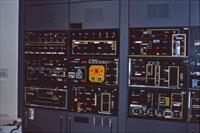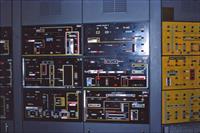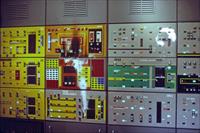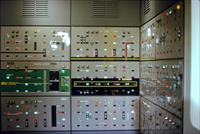Set visit
By Robin Hill
This account was written for the Nick Tate newsletter 2 in 1977.
You can count on the fingers of 2.4 hands the number of humans who have walked upon the surface of the moon. On two occasions, in October and December of last year, I joined the hallowed ranks by setting foot upon alien soil.
Well, not exactly alien. More North London, actually. Pinewood Studios, home of James Bond, The Avengers, Rollerball and (pause for effect) Space: 1999, to be more specific, the Alpha soundstage.
This is supposed to be particular account of some of the happenings on those two visits. For reasons best known to herself, Carole has asked me not to mention certain things, including why Nick has such a wide grin on his face and she looking away from the camera in one of the photos I took of them in each other's arms, or what they did on the 45 minute ride between Pinewood and King's Cross Station in Nick's Datsun 240 Z. I won't even mention that Carole spent the entire train journey home whimpering and playing "Alpha" on my cassette recorder.
Sorry Carole. And Nick, but I've so many happy (and sad) memories of those two visits that I have to tell someone or explode. So, apologies for the jumble of comments that follows; the original draft ran to seven pages and Carole is reluctant to put out newsletters that resemble "War and Peace".
Sound stage L is, from the outside at least, a great Zeppelin-hangar of a building, resembling with uncanny similarity the part of Auric Goldfinger's factory that had a blazing Mercedes rammed into in Goldfinger. Inside, it's a different story. Your immediate impression is that a particularly messy bomb has gone off in a timber yard that is currently serving as a repository for most of NASA's junked instrumentation, with rows of two by fours propping up great sheets of hardboard and perspex. But, on the other side of these apparently randomly arranged heaps of set is ...
Alpha. Living, breathing, complete with winking control consoles, TV monitors and crew. It 's quite a shock at first. I know I'm going onto the Alpha set, yet, once there with the white corridors about me, I experience an almost uncanny feeling. Yes, of course it's only a set, but I wasn't the only one there who secretly wished it was real.
I'm supposed to be giving you a technical impression of the set. True, there's plenty to be technical about. The sets are beautifully made, especially when you consider that they've all had to be built from scratch. Pinewood has one of the biggest stocks of set and scenery in the country, but even it can't hope to have on hand a whole moonbase. The instrumentation is a joy to watch. And touch - the consoles are studded with working switches - and surprisingly to hear. All those flashing lights are driven by literally hundreds of car indicator flashers. As you walk behind a "live" set, you can hear a riot of tinkling noises as the relays click over.




Photos by Robin Hill of Command Center set, 9 December 1976
But the thing that makes that set is the stars themselves. When Nick Tate or Martin Landau appear they're just a couple of actors arriving to speak their lines. But place Landau in front of Command Centre's main screen, and sit Tate behind a console and the next words you hear are spoken by Commander John Koenig and Senior Eagle Pilot Alan Carter.
So, it's professionalism. The actors live the characters. But, until I saw myself, I never realised how convinced I'd be of such a performance, surrounded by a half-set of Command Centre and a great crowd of technicians. In fact, so absorbed was I by one, rather involved exchange of lines, that I was lost for a minute when someone yelled "cut" and everything seemed to stop.
Off-camera is utter chaos. The Space team are an incredible bunch, actors and crew alike. On the second visit, Catherine Schell and Barbara Bain seemed to be waging a constant battle of dialects, each throwing some weird line or other at her opposite number. And you haven't lived until you've heard a Hungarian countess and an American TV actress yelling at each other in broad Cockney accents! Catherine Schell. *Sigh*.
Erm, Yes, this is supposed to be about the Space set, isn't it ?
To tell the truth, there is only one star of Space: 1999. He's about three feet long, and weighs just over forty pounds. And, when we made our first visit to Pinewood, was sat in a studio all on his own out at Bray. My first sight of him was through a heavy studio door, reclining sedately on a trestle table in a pool of sunlight: Eagle Four, or Ten, or whatever Eagle he was supposed to be that episode. There are at least four and a number of large scale pieces (including a 1/3rd scale section of the passenger module for ultra-close-ups). And when Brian Johnson builds a model there's no messing about. They ooze surface, detail, from the three-foot radio-controlled beastie that has working rockets (propane vapour) to the tiny six-inch mini-Eagle. Then there were Hawks, radio-controlled moon buggies, the Into Infinity spaceship, Altares, a little "Brian the Brain" and untold bits and pieces (including an Aurora model of the U.S.S. Enterprise and, inexplicably, a WW1 Fokker DrI Triplane in the war paint of Baron von Richtoven! Hmmm )
Space: 1999 lives! and Eagles Rule 0k